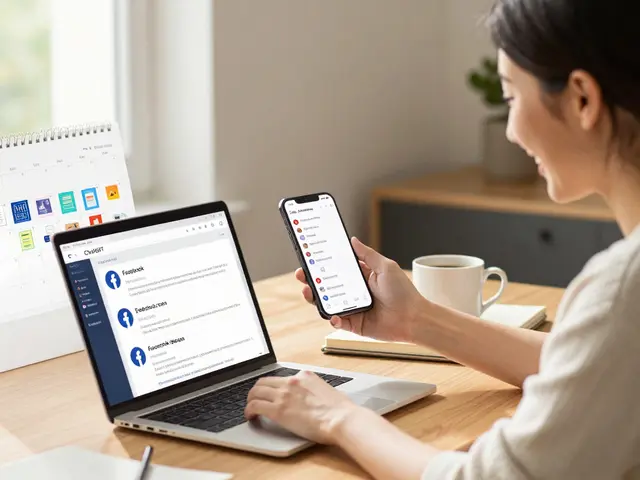You open Facebook, stare at the empty caption box, and feel that tiny panic: what do I post today? The algorithm wants consistency. Your audience wants personality. Ads want proof. And you’ve got 40 minutes before your next meeting. That gap-between what Facebook rewards and the time you actually have-is exactly where AI pulls its weight.
Here’s the honest take: you still need to steer the strategy. ChatGPT won’t magically make average content win. But used right, it turns the slow, fiddly parts-ideas, drafts, variations, replies-into a quick, reliable system. You’ll publish faster, test more, and keep your tone intact without sounding robotic.
I’m writing from Brisbane, where ad sets run on AEST and public holidays sneak up on your reach. The playbook below is practical, current, and built for teams that want high-quality output without burning weekends polishing captions.
TL;DR: Why it’s worth pairing ChatGPT with Facebook
- Save hours: turn briefs into post calendars, ad variations, and comment replies in minutes-then edit like a pro.
- Boost volume without losing voice: lock a brand style, then generate on-brand posts, scripts, and carousels at scale.
- Test smarter: ship 3-5 ad/caption variants per asset to find winners faster with the same budget.
- Protect your account: build guardrails for claims, policy, and tone so every output is safe to publish.
- Integrate: draft in ChatGPT, schedule in Meta Business Suite or your scheduler, and keep a simple human review step.
If you only remember one phrase, make it this: ChatGPT for Facebook works best as a co-pilot, not an autopilot.
Build a simple AI-powered Facebook workflow
Think in systems, not one-off prompts. The goal is repeatable outputs you trust.
-
Create a mini brand voice file (10 minutes). Paste a few of your best posts and a short description of your audience. Ask: “Extract my voice pillars (tone, vocabulary, pacing, do/don’t).” Save it. Reuse it as a preface for every prompt.
-
Map content pillars and formats. Pick 4-6 pillars (Education, Behind-the-scenes, Offers, Proof, Community, Entertainment). For formats, include static posts, reels scripts, short text posts, and carousels. This keeps variety without chaos.
-
Draft a weekly calendar in one shot. Prompt: “Using my voice file and these pillars, propose 5-7 Facebook posts for next week (AEST), with hooks, captions, and CTA ideas. Mark which could be turned into a Reel script.” Edit, then paste into your scheduler.
-
Turn briefs into assets fast. Feed the product/service facts (benefits, proof, deadlines). Ask for 3 caption angles: Problem→Fix, Social proof→Offer, and Educational→Soft CTA. Keep the best, tweak, and publish.
-
Generate ad variations at scale. For each image/video, ask for 5 primary texts (short/medium/long), 5 headlines, and 3 descriptions. Tag them by angle (value, urgency, curiosity, testimonial). Load into Ads Manager and let the data decide.
-
Comment and DM workflows. Ask ChatGPT to draft friendly, on-brand replies for FAQs, pre-sales questions, and basic support. Keep one rule: AI drafts, humans approve. For Messenger, follow Meta’s 24‑hour rule for promotional messages.
-
Review for safety and truth. Add a policy check prompt: “Flag any risky claims, superlatives, or compliance issues (health, finance, targeting). Propose compliant alternatives.” Publish only after this pass.
Below is a realistic view of time savings when you use this workflow. These are conservative, based on real client work over 2024-2025.
| Task | Manual Time | With ChatGPT | Time Saved | Quality Control Step |
|---|---|---|---|---|
| Weekly FB content calendar (5-7 posts) | 2-3 hours | 35-50 minutes | ~65% | Human edit for tone, dates, local events |
| Ad copy set (5 primary texts, 5 headlines) | 60-90 minutes | 15-25 minutes | ~70% | Policy scan + brand voice pass |
| FAQ reply bank (20 comments/DMs) | 90 minutes | 25-35 minutes | ~65% | Legal/compliance spot check |
| Repurposing 1 video into 3 posts | 45 minutes | 12-18 minutes | ~60% | Accuracy check on claims |
Important: ChatGPT can’t publish to Facebook by itself. Draft in ChatGPT, then schedule via Meta Business Suite, Buffer, Later, Hootsuite, or your preferred tool.

Prompts and examples that actually work
Prompts are only as good as the source material. Give clear facts, audience context, and constraints. Then ask for multiple angles. Here are field-tested prompts and outputs.
-
Voice calibration (do this once): “You are my Facebook copy partner. Learn my voice from these 3 posts and this description of my audience. Extract tone rules, banned phrases, and favorite hooks. Confirm back in bullets.”
-
Weekly plan: “Propose 6 Facebook posts for next week in AEST using pillars: Education, Proof, Community, Offer, Behind-the-scenes, Entertainment. For each: 1 hook, 1 caption (70-120 words), 1 CTA, 3 hashtag ideas.”
-
Caption with a hook + CTA: “Write 3 Facebook captions for [offer], audience [who], outcome [what], deadline [when]. Tone: [voice rules]. Structure: Hook (1 line) → Value (3-4 lines) → CTA (1 line).”
-
Ad copy batch: “Create 5 angles for this creative: [insert image/video description]. For each angle, write: 1 short primary text (40-60 chars), 1 medium (100-140), 1 long (200-280), 1 headline (25-40), 1 description (60-80). Label angles.”
-
Compliance filter: “Review this copy for Meta Ad Policies. Flag prohibited content, misleading claims, or targeting issues. Suggest compliant edits without dulling the benefit.”
-
Comment replies bank: “Generate 15 friendly replies to pre‑sales comments about [product]. Vary tone (warm, witty, concise). Include 3 soft CTAs to DM and 3 that ask a question to boost engagement.”
-
Repurpose long form to Facebook: “Summarise this blog into 3 Facebook posts: 1 educational, 1 story, 1 question post. Keep Australian spelling and AEST references.”
Let’s ground it with a quick example. Say you run a Brisbane gym and you’re promoting a 6‑week strength block.
Prompt: “Audience: busy 30-45yo professionals in Brisbane. Offer: 6‑week strength block starts Monday, early mornings. Proof: 120+ client transformations, 4.9★ rating. Voice: encouraging, no bro‑science. Write 3 Facebook captions: short, medium, long.”
Sample outputs (edited lightly for tone):
-
Short: Strong days start before sunrise. Our 6‑week strength block kicks off Monday-coached lifts, small groups, zero fluff. Want in? Comment “STRONG” and we’ll DM you.
-
Medium: Mornings feel different when you’ve already hit your numbers. Our coached 6‑week strength block starts Monday in Teneriffe-small groups, personalised progressions, and a crew that shows up. 120+ Brisbane transformations, 4.9★ reviews. Hit “STRONG” below and we’ll hold you a spot.
-
Long: If you’re lifting solo and guessing, it’s easy to stall. For the next 6 weeks, we’ll coach your technique, set targets you can hit, and make 6am feel like a win. Small groups. Smart programming. Real numbers. We start Monday-drop “STRONG” and we’ll DM the details.
Ads? Same raw facts, more angles. Ask ChatGPT for value, urgency, curiosity, and testimonial angles, then load them all. Your cost per result will tell you which voice your audience answers.
Checklists, guardrails, and tiny rules that save you
Speed is great until a claim trips an ad review or your tone goes off-brand. Use these to keep it tight.
Prompt QA checklist
- Did you include audience, offer, proof, deadline, and tone? If not, expect generic copy.
- Did you ask for multiple angles or lengths? Always get at least three.
- Did you specify constraints (word counts, character limits, banned phrases)? It limits waffle.
- Did you attach your voice file up front? Consistency starts there.
Copy approval checklist (publish-side)
- Truth: no unverified stats, no miracle claims, clear pricing if mentioned.
- Clarity: grade 6-8 reading level. One core message per post/ad.
- Policy: no personal attributes targeting in ad text (e.g., “Hey diabetics in Brisbane…”).
- Localisation: Aussie spelling, AEST dates, local holidays/events noted.
- Compliance: health/financial claims aligned to Australian rules (TGA, ASIC) when relevant.
Heuristics that hold up
- Hook formula: “Stop the scroll by naming a tension” → “Shift belief” → “Offer next step.”
- Test plan: Ship 3-5 variants per asset, pause losers after 1,000-2,000 impressions.
- Cadence: 3-5 quality posts/week beat 7 mediocre ones. Protect quality.
- Comment prompts: Ask genuine questions that are easy to answer in one line.
- Reels scripts: 3 scenes max, 7-9 words per on-screen line, 1 takeaway.
Policy notes you really should know
Meta uses a combination of technology, human review, and reports from our community to enforce our policies, and advertisers are responsible for ensuring their ads comply with all applicable laws.
- Messenger: Promotional messages must be sent within 24 hours of a user’s last interaction, unless using approved message tags or sponsored messages (Meta policy).
- Ad text: Avoid implying personal attributes (e.g., health, race, religion). Phrase benefits generically.
- Health/finance claims: Require evidence; in Australia, check TGA (health) or ASIC/AFCA guidance (finance).
- Influencer/UGC: If there’s material connection, clearly disclose (AANA Code of Ethics; ACCC guidance).

FAQ, next steps, and troubleshooting
Does Facebook downrank AI content? Not by default. Low-quality, spammy posts get less reach-AI or human. Keep it useful, on-brand, and sized for the platform.
Can ChatGPT post to Facebook automatically? No. Draft in ChatGPT, then publish through Meta Business Suite or a scheduler. If you use automation tools, follow Meta’s platform terms.
Will my ads be rejected if I use AI copy? Not because it’s AI. Rejections happen when copy breaks policy (claims, personal attributes, restricted content). Use the compliance prompt and review manually.
How do I keep a consistent voice? Build a voice file from your best posts, then paste it at the top of every prompt. Save winning lines and phrases in a “brand lexicon” to reuse.
Which model should I pick? Use the latest ChatGPT model you have access to for copy tasks. For long lists/variations, ask for batches of 5-10 to keep quality high.
Is it safe to paste customer data into ChatGPT? Don’t paste personal data. Anonymise examples and aggregate insights. Keep private info in your CRM, not in prompts.
What about Australian timing and seasonality? Schedule in AEST, and plan around local holidays and sport events. Ask ChatGPT to build a calendar that includes Aussie moments your audience cares about.
Next steps for different roles
- Solo owner: Build a 4‑pillar plan, generate one week of posts, test two ad angles, and create a 15‑reply comment bank. That’s a solid base.
- Agency: Standardise a brand voice template, a 6‑angle ad pack, and a compliance checklist. Roll it across clients for speed and consistency.
- Creator/UGC: Script 3 Reels per week with the same hook formula. Turn top comments into Q&A posts to keep the loop going.
Troubleshooting guide
- Copy sounds bland: Feed better inputs-add customer quotes, objections, and unique proof. Ask for “spikier” hooks and stronger verbs.
- Too wordy: Set hard limits: “Keep to 80-120 words. No more than 3 sentences per paragraph.”
- Ad fatigue: Refresh hooks weekly, not just headlines. Swap angles (value → curiosity, proof → story).
- Policy flags: Reframe benefits without diagnosing problems or naming attributes. Offer outcomes, not labels.
- Poor engagement: Add a simple question to the end of posts, or a DM me keyword for quick responses.
Quick execution bundle (copy/paste)
- Voice file opener: “Use my voice rules below for every output. If you drift, correct yourself.”
- Calendar: “Plan 5 posts for next week in AEST with hooks, captions (80-140 words), CTAs, and suggested visuals.”
- Ads pack: “For this asset, write 5 primary texts (short/med/long), 5 headlines, 3 descriptions, labeled by angle.”
- Policy check: “Review for Meta Ad Policies, Australian health/finance rules if relevant, suggest compliant rewrites.”
- Replies: “Draft 20 on-brand comment replies that encourage conversation. 30-60 characters each.”
If you’ve been stuck choosing between “fast” and “good,” this is how you get both. Keep your voice tight, your proofs real, and your tests rolling. Let the AI handle the grunt work so you can spend your time on the bits that actually move the needle-offers, creative, and conversations.




Write a comment